What Are Short Tail Keywords for SEO?

Hand off the toughest tasks in SEO, PPC, and content without compromising quality
Explore ServicesKeyword research makes the (SEO) world go round.
It is always worth investing in keyword research, but not all keywords are created equal.
They can of course vary a lot in topic, type, and length. And those differences have a big impact on how you optimize your website for them.
Take short-tail keywords for instance. Whilst typically harder to rank for than their long tail counterparts, they are still valuable search terms to target (if you want to reach the right audience).
Don’t get bogged down in semantics, here’s our guide to short-tail keywords, what they are, and why they’re important.
What Are Short Tail Keywords?
Short tail keywords are search terms that are made up of no more than three words. They refer to very broad topics rather than specific ones.
For example, “running shoes” is an example of a short tail keyword while “best running shoes for winter” is an example of a long tail keyword.

In this example you will notice that the long tail keyword contains the broad short tail version.
Short tail keywords are often used as a “seed” that you can use to find several longer variations of search terms. That is why there are a few alternative names for them, like:
- Focus keywords
- Broad keywords
- Head terms
- Seed keywords
Short tail keywords also tend to have very high search volume, because they are so broad.
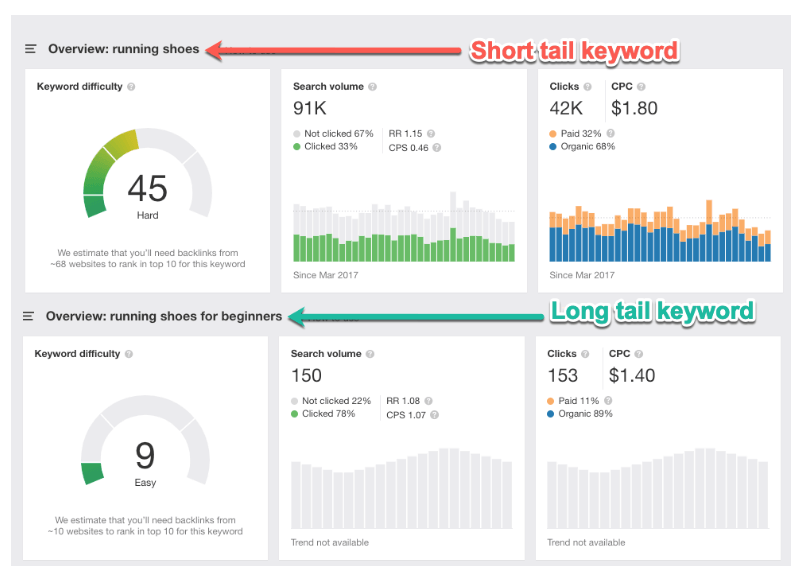
Lots of people search for a given seed keyword to start their search into a specific topic. While ranking for a short tail keyword can be difficult, they are also highly valuable to your business.
Why use short tail keywords?
The big benefit of optimizing your website for short tail keywords is because they have the highest amount of searches per month.
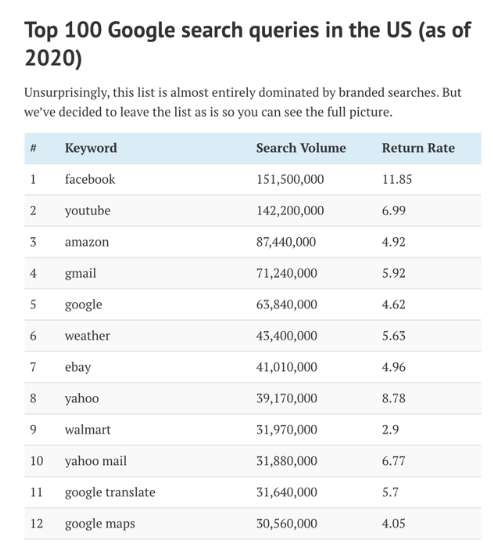
Source: Top Google Searches by Ahrefs
In fact, according to one study 10,000 most used keywords are virtually all short tail. They also make up almost 20% of all searches, out of millions of all keywords.
That makes them the biggest opportunity to get more traffic and conversions to your website from organic search. However, the high volume and broad meaning also makes short-tail keywords highly competitive.
This is part of the ‘search demand curve’.
There is a direct connection between the length of a keyword with higher search volumes and levels of competition. If you research what keywords are, you’ll see several variations of this kind of graph to explain search demand curves:
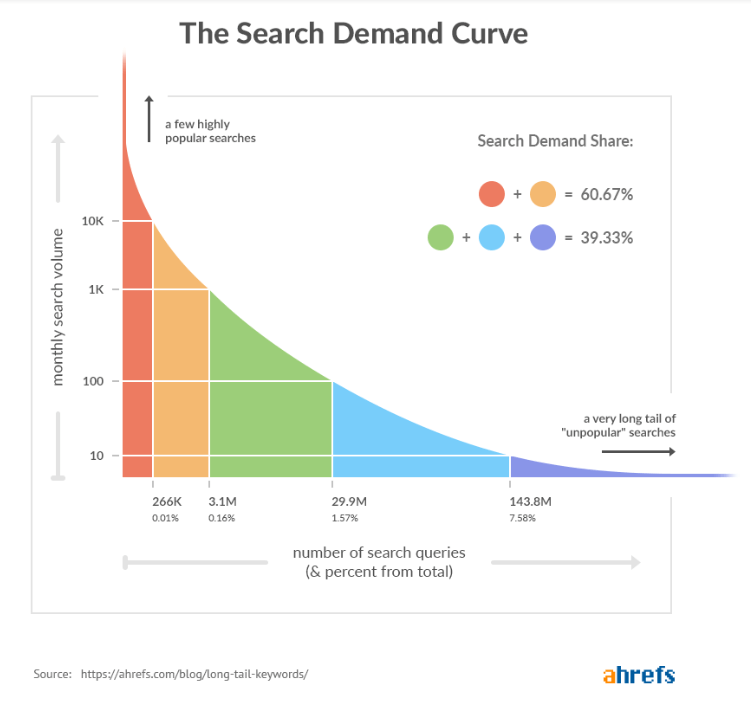
Source: https://ahrefs.com/blog/long-tail-keywords/
This doesn’t mean you should only try and optimize your website for short-tail keywords. Remember that seed keywords are also found in tons of long tail keywords.
So if you optimize your content for long tail keywords, it will help you also rank for the short, broad keywords.
Fed up of doing keyword research?
Let us do it for you. Give us topics/seed keywords and our team of SEOs will research these (+ find related terms, do some search intent analysis and topic grouping).
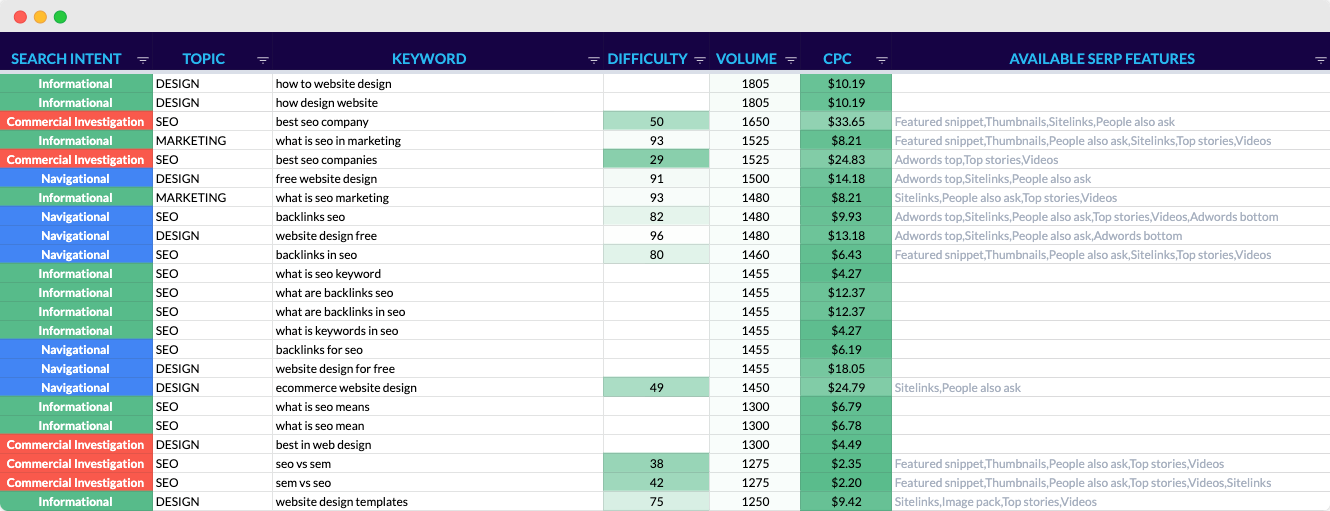
3 Short Tail Keyword Examples
We mentioned above that short tail keywords tend to have higher search volume, but they’re more competitive as a result. This is because broader keywords can have different user intent behind the search.
Someone searching for “running shoes” may want to learn about them or buy them. They may also want to look up a picture of shoes for a school project or for their own website.
That is why broad keywords have higher search volume, but are also more competitive. The competition makes short tail keywords cost more to rank, and come with lower conversion rates.

Here are three examples of short tail keywords to explain their difference from long tail versions.
#1) Local keywords (Real estate)
First, let’s look at local keywords.
These are search terms that are specific to a geographic location. Basically, you just need to take the seed keyword and add local modifiers to get long tail keywords.
Let’s use “real estate” as an example of a short tail keyword, and apply localized modifiers to it for a business based in Queen Anne, Seattle.
Here is an example of the seed keyword and some variations of local long-tail keywords:
- Real estate
- Washington real estate
- Seattle Washington Real estate
- Queen Anne Seattle Real Estate
And the keyword data:

Notice how this one business could rank for keywords at the state, city, and neighborhood level?
They are all applicable to their business and location. Here’s how the search volume for those different keywords looks like:
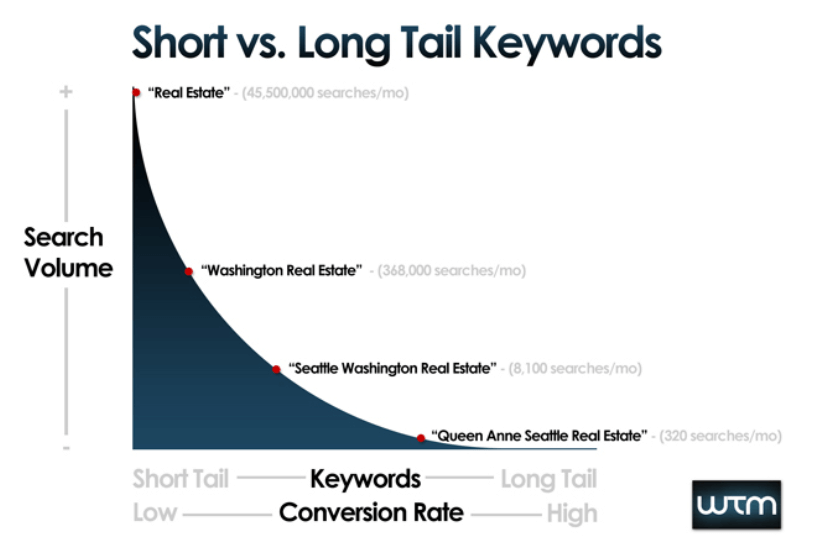
Source: https://www.bounteous.com/sites/default/files/luna-migrate/short-vs-long-tail-keywords1.jpg
You will notice that the more general the keyword is, the higher the search volume and competition it has.
That’s because “Washington real estate” can apply to more topics and locations than “queen anne seattle real estate”.
That’s also why more specific keywords have a higher conversion rate. If you are someone in Queen Anne Seattle looking for a real estate agent, you are more likely to click on a website if it is located close to you.
Ranking #1 for “Seattle Washington Real Estate” and other important local real estate SEO keywords is valuable because you will get more clicks. But it will be harder to rank #1 because more businesses will also be trying to rank for it. You will also have a lower click rate from it.
#2) Ecommerce keywords (t-shirts)
Let’s use “t-shirts” as an E-commerce seed keyword for another example.
T-shirts by itself is a broad keyword that has a lot of searches. People who only search for that term may be looking to buy a t-shirt, or they could have a different intent.
Maybe they want to make their own shirt, or buy them from a store. If they want to buy them, they might want men’s, women’s or children’s shirts. They may want a shirt for their band, or a plain white shirt to wear under their work clothes.
Here are three keywords that show the progress from short to long tail keywords:
- T-shirts
- Blue t-shirts
- Blue american apparel t-shirts
And the keyword data:

Again, notice the progress from broad to specific in terms of the information the search term conveys.
When people are looking for products to buy online, you should want your ecommerce website to rank for all of them. As long as you have products that match the keywords, that is.
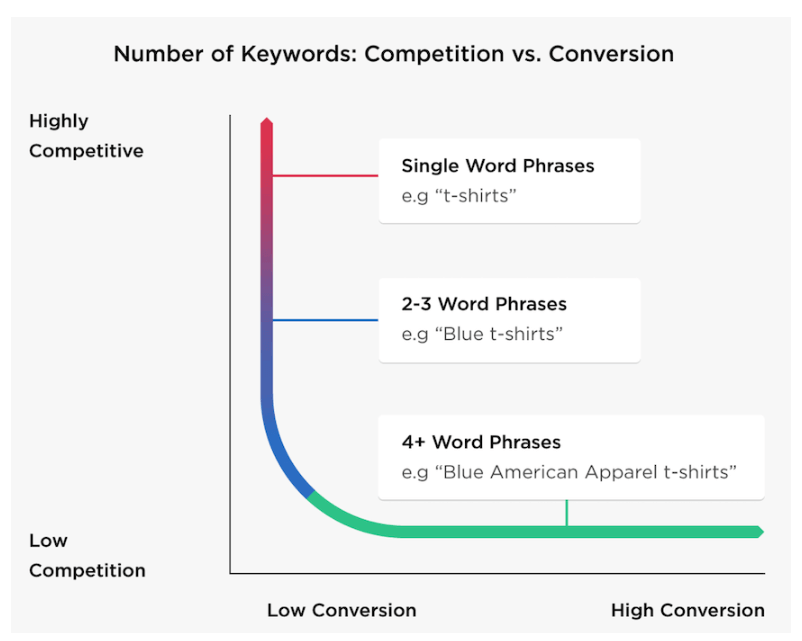
Like the real estate example above, you will find different types of performance for these keywords. Your website will have more total impressions and clicks for the short-tail version, but it will cost more in time and effort to rank for it.
The longer and more specific the keyword, the lower the total impressions and clicks will be. But you will also have a higher conversion rate and it will be easier to rank for them.
#3) Digital product keywords (wordpress themes)
Lastly, let’s look at a digital product keyword as an example.
If you are a programmer or a business that creates and sells WordPress themes, you will know just how diverse the themes can be. That’s because there are many different types of websites.
Someone who just searches for “wordpress themes” may want to download or buy a theme for their own website. But they might also be a programmer themselves looking to get into making their own. Or they could be a website with an existing theme with a technical problem they are troubleshooting.
Here is an example of the progress of a short and broad keyword becoming longer and more specific:
- WordPress themes
- WordPress themes for blog
- Free responsive wordpress themes for blog
And the keyword data:

The first modifier added to the seed keyword specifies the digital product (wordpress themes) for a specific kind of website (a blog).
The next modifiers then add a specific type of functionality (responsive) and cost (free). Here is the effect that each set of modifiers has on the search:
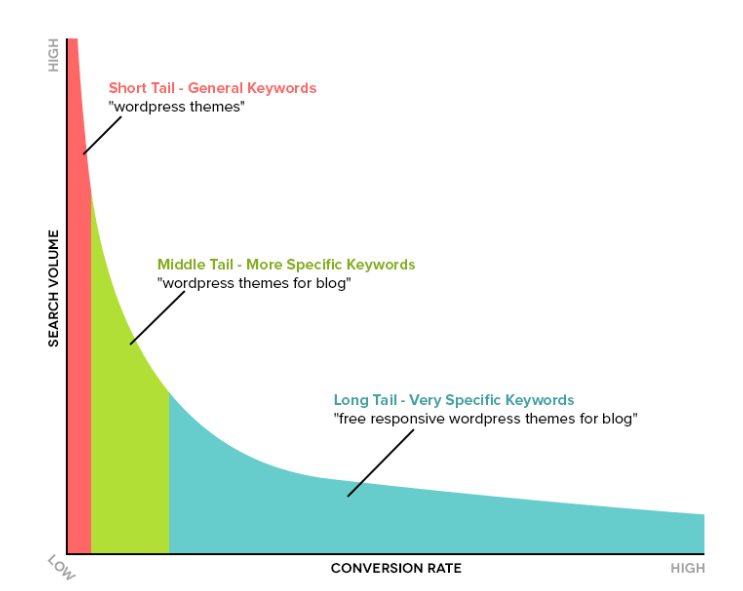
Source: https://sherpa2017.blob.core.windows.net/images/contenthub-posts/06-2019/keywords—word-chart.png
Once again you can see the progress on the graph as a keyword gets longer and more specific. If your website provides wordpress themes, you will want to optimize it to rank for the short tail keyword.
That will get your website in front of far more people, and get more clicks in total.
But when you also optimize for the longer versions, you also help rank for the short tail keyword. That’s because the long tail keywords almost always contain the seed keyword.
Short Tail vs Long Tail Keywords
In the three examples above, you may be wondering if it’s more valuable to rank for short or long tail keywords.
You may see the higher levels of competition and lower conversion rates and get scared away from short tail search terms.
However, short tail keywords still have a much greater opportunity and are very important to your business. Here are the pros and cons.
Benefits of short tail keywords:
- Higher search volume
- Greater opportunity to get your website in front of more potential customers
- More total clicks and conversions for just the one keyword
Drawbacks of short tail keywords:
- Much more competitive to rank for short tail keywords
- Broader range of user intent makes it more difficult to create the right content for it
- Lower click and conversion rates, and higher cost per click
The truth is that you should optimize for short and long tail keywords as part of a balanced SEO strategy.
Optimizing your website for short keywords will get you more awareness and total clicks to drive more business.
But optimizing for long tail keywords will give you higher converting traffic for less effort and cost.
It will also help you rank higher for the seed keyword. When you put the work in to rank well for all of them, you reap all the potential benefits.
Summary
Ranking for short tail keywords represents the biggest opportunity for your website.
They have huge amounts of search volume, so ranking #1 for them would lead to a massive return on your investment.
Even though there is usually more competition for short tail keywords, it’s still worth the effort to optimize your website for them.
But the best way to rank for them isn’t to only focus on short tail search terms and ignore everything else. Optimizing for longer versions of a seed keyword also helps you rank better for the short tail version.
Hand off the toughest tasks in SEO, PPC, and content without compromising quality
Explore ServicesWritten by Jake Sheridan on June 25, 2020
Founder of Sheets for Marketers, I nerd out on automating parts of my work using Google Sheets. At Loganix I build products, and content marketing. There’s nothing like a well deserved drink after a busy day spreadsheeting.





